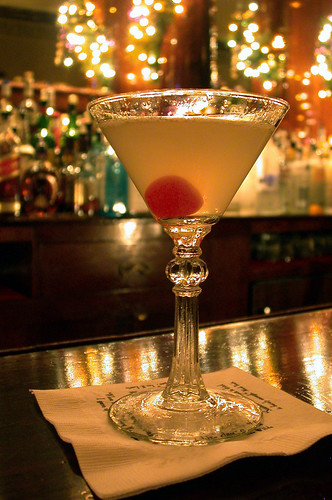Pan-Galactic Gargle Blaster
The ultimate answer to the ultimate question of Life, the Universe and Everything. That’s me! Today, November 11, 2003, I am 42.
It was very nice of them to design the Earth-sized and -shaped computer Deep Thought and have it work on me for billions of years. I only wish I knew what the question was.
Given the significance of today’s birthday, there really can be only one drink with which I can celebrate. Robb was thoughtful enough in another comments thread to suggest Sazeracs — a splendid suggestion, no doubt — but today only this will do.
The best drink in existence, according to Douglas Adams, is the Pan-Galactic Gargle Blaster. The effect of drinking one of these is rather like having your brains smashed out with a slice of lemon, wrapped around a large gold brick. The Hitchhiker’s Guide to the Galaxy will tell you on which planets the best ones are brewed, how much you can expect to pay for one, and which voluntary organizations exist to help you recover afterwards.
Fortunately, the Guide also tells you how you can make one yourself. (And, of course, it’s gin-based.)
Pan-Galactic Gargle Blaster
1 bottle Ol’ Janx Spirit.
1 measure Santraginean seawater.
3 cubes frozen Arcturan MegaGin.
4 liters Fallian marsh gas.
1 measure Qualactin Hypermint Extract.
1 Algolian Suntiger tooth.
Zamphour to taste.
Olive garnish.Take the juice from one bottle of the Ol’ Janx Spirit (see page 15 of the actual Guide).
Pour into it one measure of water from the seas of Santraginus V — Oh, that Santraginean seawater, it says. Oh, those Santraginean fish!
Allow three cubes of Arcturan MegaGin to melt into the mixture (it must be properly iced or the benzene is lost).
Allow four liters of Fallian marsh gas to bubble through it, in memory of all those happy hikers who have died of pleasure in the marshes of Fallia.
Over the back of a silver spoon float a measure of Qualactin Hypermint Extract, redolent of all the heady odors of the dark Qualactin Zones, subtle, sweet and mystic.
Drop in the tooth of an Algolan Suntiger. Watch it dissolve, spreading the fires of the Algolan suns deep into the heart of the drink.
Sprinkle Zamphour.
Add an olive.
Drink… but… very… carefully.
If my brains are bashed out, I’ll just get a second head.








